Chromed Sword Kilt Pin with Celtic Shield Design
Original price was: $30.$20Current price is: $20.Chromed Sword Kilt Pin with Celtic Shield Design
Cheap Kilts Instant Regret. Try Premium Kilts & Thank Us Later.
It’s a small detail, the kilt pin, and maybe easy to overlook at first. But once you wear one, especially the right one, you sort of wonder how you ever left it out. It’s like… a quiet punctuation mark on the bottom corner of your kilt. Not loud, but noticeable.
Traditionally, a kilt pin on a kilt is worn at the lower corner of the outer apron. It’s not just decorative—though let’s be honest, that’s half the fun—it also helps keep the kilt from flapping too much in the wind. Function meets style, and all that.
In our collection, you’ll find a range of Scottish kilt pins, from bold Celtic crosses to subtle sword motifs. Some are polished, others aged. We’ve tried to keep the options balanced—though, sometimes, it’s the slightly odd designs people end up loving most.
There are antique kilt pins with a bit of character, and vintage kilt pins that feel like they’ve lived a life before landing on your kilt. Not everyone wants something shiny and new. Some prefer a piece that looks like it has a story already.
Then there’s silver. A silver kilt pin—real or silver-tone—has that clean, timeless appeal. You don’t really have to think about matching it. It just fits in. That’s what makes it the go-to for a lot of people.
And if you’re not sure what to pick? That’s alright. Even longtime wearers experiment. Choosing a kilt pin is more personal than you might expect. What feels right one day might not the next. That’s part of the fun.
You could skip the pin. Technically. But the look wouldn’t quite be finished. It’s not about standing out—it’s about completing the story your kilt tells.
Browse through. You might be surprised what catches your eye.
Showing all 9 results
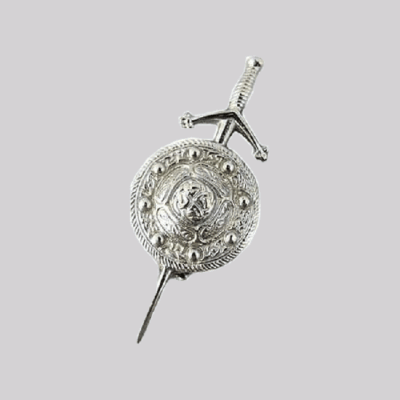
Chromed Sword Kilt Pin with Celtic Shield Design
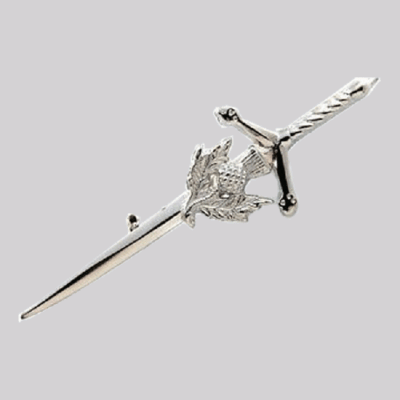
Handcrafted Scottish Kilt Pins
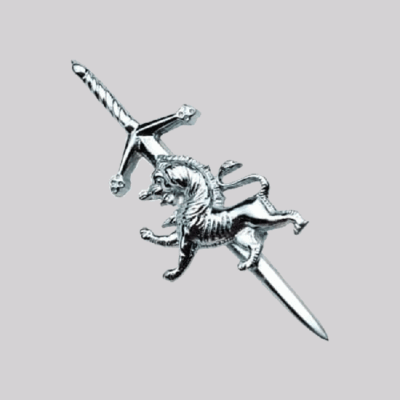
Highland Scottish Rampant Lion Kilt Pin Chrome Finish
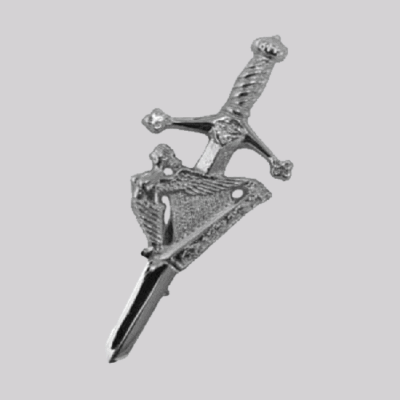
Irish Harp Kilt Pin Custom
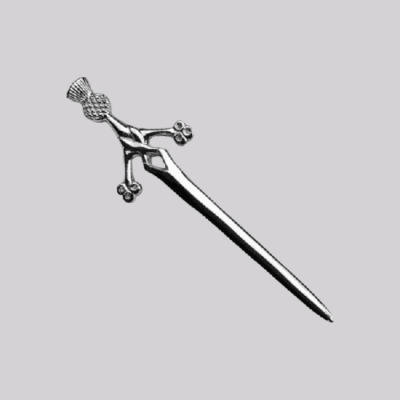
New Deluxe Claymore Thistle Head Kilt Pin
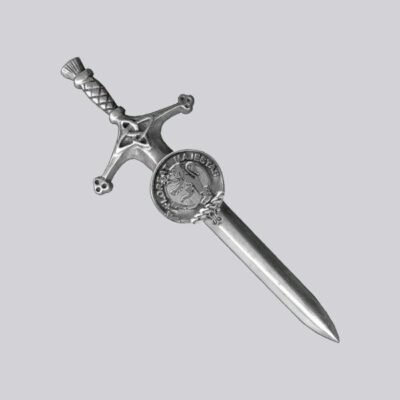
Scottish Brown Clan Kilt Pin
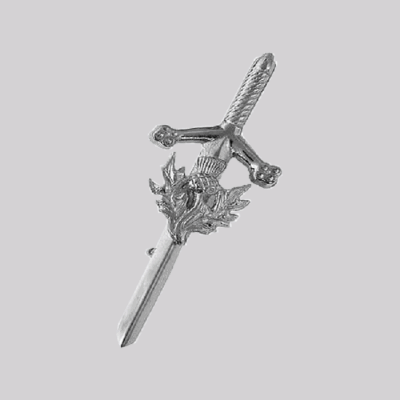
Scottish Highland Accessories Celtic Kilt Pin
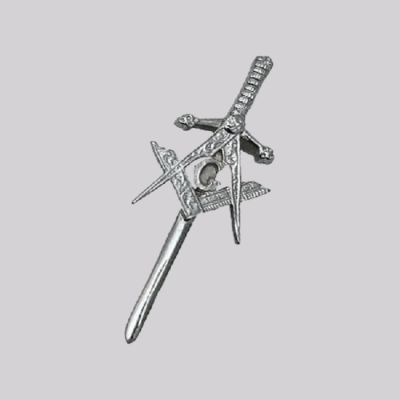
Scottish Highland Masonic Kilt Pin
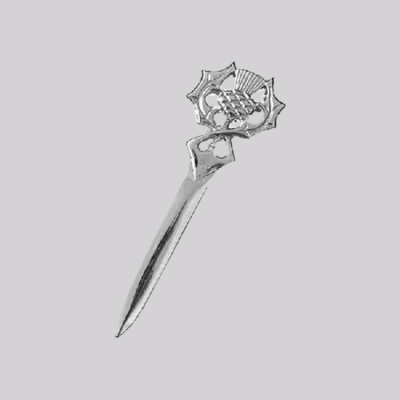
Scottish Thistle Kilt Pin with Chrome Finish
A kilt pin adds weight to the front apron of a kilt to prevent it from lifting and flapping, especially in windy conditions. It also serves as a decorative accent.
It should be pinned through only the outer apron of the kilt, on the lower right corner, about 2–4 inches from the bottom and side edge.
Yes! We offer custom engraving and clan badge kilt pins to represent your family heritage or personal identity.

A kilt pin might seem like a small addition. But, really, it does more than just accent the tartan. It often holds weight—both literally and figuratively. Not just in keeping that front apron of your kilt from flapping too much (some people debate how much it helps, but most agree it makes a difference). But also in how it finishes the outfit.
I’ve worn kilts in weather that would make some people question sanity. Windy days where the plaid seems poised to take flight. A kilt pin on kilt can help anchor that apron. But even on calm days, it gives the look just a little structure. Like the finishing touch you didn’t know you needed.
There’s a bit of etiquette and tradition around pinning. Technically, you place the pin through the front apron—right of center—and through both thicknesses of cloth. But you don’t want it going into the pleats, or you risk pulling the hang of the kilt out of shape. So, yes—it needs placement. But rules? Less important than how it makes you feel.
Do you have to wear one? No. Many kilts look fine without. I once attended a casual ceilidh without one—no big deal. But at formal events—a wedding, a Burns supper—a pin kilt adds that note of intent. It says, “I’ve thought about this look.”
You might notice different styles: the Scottish kilt pins, Irish kilt pins, Celtic kilt pins—each brings its own flavor.
Irish kilt pins often feature Celtic knotwork or shamrock motifs. They lean slightly more ornate, maybe less badge‑focused.
Scottish kilt pins might carry clan symbolism, thistles, or more formal shield shapes—often deeper in tradition.
Celtic kilt pins pull in the knotwork or spiral designs that cross both Scottish and Irish cultures, and feel timeless. They’re a safe choice if you want pattern and meaning without a specific family focus.
I tried a Celtic knot‑style pin once. It caught light in just the right way at an outdoor wedding—I ended up getting comments from people who didn’t even know what a kilt was. So subtle, yes—but it sticks in the mind.
Then there are the vintage kilt pins and antique kilt pins. A few decades old, maybe passed down. Or just styled to look like they have history. Those come with patina and depth. You often see smoky silver, slight wear, and a feel that someone else wore it decades earlier.
Custom kilt pins—on the other hand—offer something personal. Maybe your initials, or a design you commissioned. It doesn’t have to be loud. Even a small Board of your clan name in script can make the piece feel yours.
We also offer clan kilt pins, which feature clan crests mounted on classic pin shapes. Great if you’re representing a lineage. But there’s room for flexibility—maybe your pin nods to clan heritage and a sports club. That’s okay, too.
Most of us lean toward silver kilt pins, for their shine and classic look. But there are brass options, antique finishes, black plated—each offering a different mood. Silver feels formal. A darker finish reads casual. Whatever suits the rest of your look.
Material matters too: solid metal vs. plated vs. pewter. And weight matters—too light, and it flaps; too heavy, and it might pull the kilt out of shape. We’ve tested each style on kilts at our photo shoots, just to make sure they “work.” Function meets fashion there.
On our site, you’ll find kilt pins for sale across those styles—Scottish, Irish, vintage, antique, custom, even fun ones with Celtic flair. We try to keep the collection curated, rather than overwhelming.
Each listing includes close‑up images—some even show the pin on a kilt apron. Because context matters. You’ll see how it sits, how it reflects light, and whether it feels like a small accent or a noticeable statement.
We’ve also tagged pins by theme—heraldic, knot, clan, vintage finish—so you can browse by purpose or style inclination. Helpful if you think you want to match a clan tartan, but aren’t sure.
A kilt pin is easy to overlook, frankly. But once you wear one, it becomes part of the rhythm. You notice how the kilt hangs, how the tartan drapes. And maybe you remember someone else’s pin—vintage, shining, sentimental—and suddenly yours has more than just function. It has character.
Whether you’re drawn to Irish kilt pins, Scottish kilt pins, or something antique, the right pin picks up where your kilt leaves off. It balances, amplifies, completes. And if it also tells a story—your story—that’s worth it.
No products in the cart.